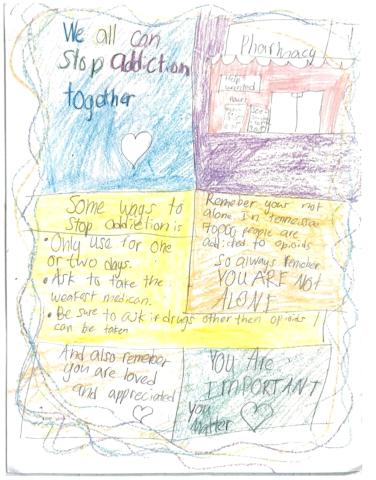Paulette 5th graders research opioid addiction and its effects
Opioid abuse across the country is at epidemic proportions, and the abuse is at its worst in poor rural communities. Of all 50 states in the US, Tennessee ranks third in opioid abuse. Opioid use has ravaged the rural Appalachian region of East Tennessee, both with its prevalence and with its destruction of families.
The COURAGE (Combating Opioid Use in Rural Appalachia with Grace and Evidence) grant is from the Health Resources and Services Administration (HRSA). In partnership with iCare Union County, the UT Department of Public Health and Tracy Jackson (4th and 5th grade Social Studies teacher at Paulette Elementary School) a program was designed and implemented for her 5th grade social studies students.
This program required a strong, long-term academic commitment from these students and this commitment meant that they would meet every Friday at their normally scheduled Social Studies class time for the entire school year to research, read, question and learn about addiction and opiates. On May 10, each of these three classes presented what they had researched and learned at their regular class time.
Each class was broken down into separate groups presenting different aspects of the topic. The program was entitled “Empowering Youth Voices: 5th Grade Student-Led Advocacy Against Opioid Abuse Disorder.”
Attending this day-long session were Laurie Meschke MD, PhD (UT Public Health Department), Mindy Grimm, CPS I (Union County iCare), Tyler Menton, PharmD, MPH, BCPS (UT Assistant Professor of Pharmacy), several Masters of Public Health students, Anna Marie Cooksey (Public Health Educator for Union and Grainger counties), Missy Fugate (Principal of Paulette Elementary), a few parents, Mayor Jason Bailey and other staff/students of UT. There was a question and answer period at the end of each session.
The individual groups had a UT graduate student as a mentor to help them with computer skills and focus their research. Each presentation had a excellent slide show created by the students that complemented their presentation. Graduate research assistant Imelda Gutierrez facilitated the sessions.
The primary causes of opioid addiction have been prescription opioids either being over-prescribed, taken inappropriately or for too long. Over 83 percent of adolescents had unsupervised access to prescription medications. Teen athletes are 50 percent more likely to abuse opioids that non-athlete students. They are driven to get back on the field, back in the game, back to the competition and are likely to push themselves, take too much for the pain, in order to meet those goals. There is a 52 percent use of opioids in the National Football League.
The formula for addiction to opioids includes over prescription of the medication, poverty, lack of available jobs, lack of access to treatment, a lack of awareness of the issue and the stigma of addiction. The students informed us that Opioid Use Disorder (OUD) comes from a particular class of drugs—poppy plants. These drugs change the brain chemistry of the user and can cause depression and anxiety. It becomes difficult for the user to find pleasure without the drug. Personality disorders, including bipolar disorders, can occur.
Advocacy for the addicted was repeated in each presentation. There was concern for those who need assistance but are low income and without insurance. The stigma of addiction prevents people from seeking help or even letting people know of the struggle. Feeling stigmatized can make people with addiction issues less willing to seek treatment. It was mentioned that some of the attitude concerning addicts actually comes from those who should know better—pharmacists and health care workers. Several students mentioned the National Institute of Health “Words Matter” paper which states “Addiction is a chronic but treatable medical condition. Often unintentionally, many people still talk about addiction in ways that are stigmatizing—meaning they use words that can portray someone with a substance use disorder in a shameful or negative way and may prevent them from seeking treatment.” Jackson’s social studies students felt that Words Matter should be a required study for anyone entering a healthcare field.
Each group’s slide presentation was excellent, and they designed their own handouts. Some students chose manual artwork to get their point across while others worked with a computer program to design their flyers. Students felt that informational and educational flyers should be available wherever large number of people meet.
During one of the question and answer periods, Mayor Bailey told the students that awhile back, some district attorneys sued the pharmaceutical companies for pushing addictive medications without appropriate warnings. The attorneys won their lawsuit and now there is an Opioid Abatement Grant that all counties receive for 18 years to help with the addiction issue.
Bailey informed the students that Union County receives $500,000 a year to use for this purpose. He asked the students if they had any ideas on the best way to spend some of this grant.
One student pointed out that there are not enough local resources for people needing therapy, and the mayor agreed. He indicated that there is a therapy bus that comes to Union County once a week, but that probably does not meet the need. Union County now has a Recovery Court. When someone is arrested with an addiction charge, this court helps to guide them through the process of recovery.
Bailey informed the students that there is a group that meeting in the small courtroom at 9 a.m. on the last Friday of every month to discuss these issues and he encouraged these students to participate. The Union County Health Department has many resources for substance abuse disorder.
If the Paulette Elementary School 5th grade is an example of our future leaders, we are in good hands. All students received a goodie bag and a certificate of completion for their work on this project.
https://nida.nih.gov/research-topics/addiction-science/words-matter-pre…
- Log in to post comments








